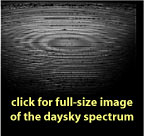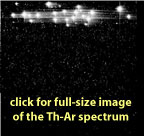Taking a Test Exposure
Initial Spectrograph Settings
The spectrograph must be given some reasonable initial settings for a successful test exposure. You'll need to enter ballpark numbers for the "Grating Tilt," "Dewar Height," and "Dewar Focus" values in the spectrograph control program hammotor_gui. You may have numbers from a previous run or from a colleague, or if you are following another observer (i.e., yours is not the first night of a Hamilton run) and using the same CCD, you can begin with the current hammotor values -- however, you should jot these down now, as they will be lost when (and if) you recalibrate the spectrograph as described in the next paragraph. Unless you have a good reason not to do so (e.g., you're continuing the program of the last observer, or you are completely confident that settings you are inheriting from the previous observer are reliable) you should begin by re-calibrating all spectrograph motors by clicking Actions - Re-calibrate all in the hammotor user interface. This will drive all spectrograph stages through their fiducials, reestablishing their zero positions (note that the Hamilton does not use absolute encoders and therefore its settings are only as good as its knowledge of its zero positions). When the recalibration has completed, enter inital values for "Grating Tilt," "Dewar Height," and "Dewar Focus," from whatever source you are using. If you have no clue what values to begin with you can try the following or or check with the support astronomer on duty.
| Spectrograph settings you might try if you have no clue of where else to begin. | |||
|---|---|---|---|
| CCD | Grating Tilt (steps) |
Dewar Height (steps) | Dewar Focus (microns) |
| Dewar 4 | 9251 | 3292 | 1026 |
| Dewar 6 | 9046 | 1450 | -2564 |
| Dewar 8 | 9309 | 3195 | -3759 |
| Slit | Aperture | Science Filter | Calibration Lamp |
|---|---|---|---|
| This will automatically assume a value of 2200 microns when an aperture is selected. | Select an appropriate aperture: 640:2.0 (L) or 640:2.5 (M) is a good starting place. | Science Filter should be set to Open. | Calibration Lamp may be set to Thorium-Argon or, if daylight is illuminating the slit (see Navigating the Spectrum), Off |
Initial Array Settings
In the Data-Taker, set the following parameters:| Integration Time | Window | Shutter | Readout Speed | Recording |
|---|---|---|---|---|
| 5 seconds | Whole CCD | Open | Fast | Don't Record |
The Test Exposure
Start the test exposure by clicking "Start Exposure" in the data-taker. It will take about 60 or 90 seconds to read out (depending on the detector in fast readout speed). When the image appears in the XVideo display, it should look something like one of the two at left. If your test image looks at all like the examples given here, you are ready to continue on to the next step, Positioning the Spectrum.Troubleshooting
If your test image is blank, or very different from the examples, consider the following problems and solutions: 1. Image is blank: In almost all cases this reduces to one of two problems: Either no (or very little) light is getting to the CCD, or the CCD and data-taking system are not communicating. To help distinguish the problem's cause, roll the cursor over the image and watch the individual pixel values in the XVideo display's control window.
1a. Image is blank, no variation in pixel values: If all the
pixels have the same value (usually, but not necessarily, zero), the
data-taker system and CCD controller are not communicating. It's time
to call a technician or support astronomer. (If you are familiar with the
Hamilton, you can first try cycling power to the CCD controller and
restarting the data-taker software. But if the problem persists, seek
assistance.)
1b. Image is blank, pixel values vary randomly: If the pixels
show random variations on the order of +/- 5 or 10 DN, than readnoise
is present and the data-taker is communicating with the CCD
controller. This does not completely rule out an electronics problem
(e.g., the CCD might be incorrectly cabled and readnoise could still
be present), but it's a pretty good indication that something is
preventing light from reaching the CCD. Check the following:
2. Image is not blank but does not resemble the examples:
As with a blank image, this problem could have either ane optical
or electronic cause. The latter is less likely.
Software or electronic problem:
Double-check the settings in hammotor. If they look OK, and
you have not already done so, consider using hammotor's
Actions - Re-calibrate all function to reset all spectrograph
motors, then reenter reasonable initial values.
Did you remember to turn the lamp on or bring in the day sky?
Double-check settings in the data-taker. Is "Shutter" set to "Open"
and not to "Closed"?
Is the CCD ID near the top of the data-taker window displaying the
correct CCD?
When you attempt an exposure, does the data-taker display
In the slit room, check to make sure the light is getting to the slit.
In the camera room, check to make sure that nothing is obstructing the
lightpath.
* "Erasing CCD" before the beggining of the exposure?
* "Shutter Open" at the beginning of the exposure?
* "Time Elapsed and Time Remaining" during the exposure?
* "Readout in Progress" during readout?
* "Observation Completed" at the end of the readout?
Optical or mechanical problem
* "Shutter Open" at the beginning of the exposure?
* "Time Elapsed and Time Remaining" during the exposure?
* "Readout in Progress" during readout?
* "Observation Completed" at the end of the readout?
* Is something obstructing the entrance slit/aperture plate?
* If you're using the day sky, turn out the slitroom lights and make sure you can see sunlight on the aperture plate.
* If you're using the Thorium-Argon lamp, make sure it's turned on by looking up above and behind the slit for the its blue glow. (It's easier to find with the slitroom lights extinguished.)
* If you're using the day sky, turn out the slitroom lights and make sure you can see sunlight on the aperture plate.
* If you're using the Thorium-Argon lamp, make sure it's turned on by looking up above and behind the slit for the its blue glow. (It's easier to find with the slitroom lights extinguished.)
* Are all the spectrograph covers open?
* Climb up on the wooden platform below the filter wheel and shutter. Open the shutter manually using the lever on its rim. Looking straight up into the shutter can you see the light coming through the entrance aperture? Is there a filter in the way?
* Is the correct dewar installed?
* Climb up on the wooden platform below the filter wheel and shutter. Open the shutter manually using the lever on its rim. Looking straight up into the shutter can you see the light coming through the entrance aperture? Is there a filter in the way?
* Is the correct dewar installed?
2a. Image show banding or other periodic pattern: This is almost
always a symptom of an electronics problem. If you are familiar with the
Hamilton, you can first try cycling power to the CCD controller and
restarting the data-taker, but if the problem persists, seek assistance
from a technician or
support astronomer.
Grating Tilt, Dewar Height, and especially Dewar Focus settings that are way out of
range could cause this problem. Double-check the settings in hammotor.
If they look OK, and you have not already done so, consider using
hammotor's Actions - Re-calibrate all function to reset all spectrograph motors,
then reenter reasonable initial values.
Were the camera-room or anteroom lights left on?
Had the shutter been manually opened, but not closed?
Is the correct CCD installed?
2b. Image shows what appears to be illumination, but nothing that looks like spectral orders or emission lines can be seen in day sky or Thorium-Argon exposures, respectively: This begins to get into an area that is more difficult to troubleshoot and will likely require the help of a technician or support astronomer, but a few possible causes can be easily investigated:
Support Astronomers (sa@ucolick.org) Last modified: Fri Feb 25 11:32:49 PST 2011

